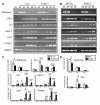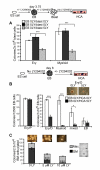Phosphoinositide 3-kinase signalling regulates early development and developmental haemopoiesis
- PMID: 17456549
- PMCID: PMC1906847
- DOI: 10.1242/jcs.003772
Phosphoinositide 3-kinase signalling regulates early development and developmental haemopoiesis
Abstract
Phosphoinositide 3-kinase (PI3K)-dependent signalling regulates a wide variety of cellular functions including proliferation and differentiation. Disruption of class I(A) PI3K isoforms has implicated PI3K-mediated signalling in development of the early embryo and lymphohaemopoietic system. We have used embryonic stem (ES) cells as an in vitro model to study the involvement of PI3K-dependent signalling during early development and haemopoiesis. Both pharmacological inhibition and genetic manipulation of PI3K-dependent signalling demonstrate that PI3K-mediated signals, most likely via 3-phosphoinositide-dependent protein kinase 1 (PDK1), are required for proliferation of cells within developing embryoid bodies (EBs). Surprisingly, the haemopoietic potential of EB-derived cells was not blocked upon PI3K inhibition but rather enhanced, correlating with modest increases in expression of haemopoietic marker genes. By contrast, PDK1-deficient EB-derived progeny failed to generate terminally differentiated haemopoietic lineages. This deficiency appeared to be due to a requirement for PI3K signalling during the proliferative phase of blast-colony-forming cell (BL-CFC) expansion, rather than as a result of effects on differentiation per se. We also demonstrate that PI3K-dependent signalling is required for optimal generation of erythroid and myeloid progenitors and their differentiation into mature haemopoietic colony types. These data demonstrate that PI3K-dependent signals play important roles at different stages of haemopoietic development.
Figures







References
-
- Ali K, Bilancio A, Thomas M, Pearce W, Gilfillan AM, Tkaczyk, Kuehn N, Gray A, Giddings J, Peskett E, et al. Essential role for the p110δ phosphoinositide 3-kinase in the allergic response. Nature. 2004;431:1007–1011. - PubMed
-
- Bi L, Okabe I, Bernard DJ, Nussbaum RL. Early embryonic lethality in mice deficient in the p110beta catalytic subunit of PI 3-kinase. Mamm Genome. 2002;13:169–172. - PubMed
-
- Bi L, Okabe I, Bernard DJ, Wynshaw-Boris A, Nussbaum RL. Proliferative defect and embryonic lethality in mice homozygous for a deletion in the p110alpha subunit of phosphoinositide 3-kinase. J Biol Chem. 1999;274:10963–10968. - PubMed
-
- Cantley LC. The phosphoinositide 3-kinase pathway. Science. 2002;296:1655–1657. - PubMed
Publication types
MeSH terms
Substances
Grants and funding
LinkOut - more resources
Full Text Sources
Other Literature Sources
Medical
Molecular Biology Databases
Research Materials
Miscellaneous

